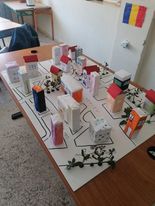Την Πέμπτη 3 Μαρτίου 2022 επισκέφτηκε το 13ο Δημοτικό Σχολείο Καλαμάτας η αναπληρώτρια Υπεύθυνη του Κέντρου Περιβαλλοντικής Εκπαίδευσης Καλαμάτας κ. Ιωάννα Ραβάνη με στόχο να υλοποιήσουν οι μαθητές και μαθήτριες της Στ΄ τάξης του σχολείου, δραστηριότητες σχετικά με τις έννοιες της «βιώσιμης» πόλης, του φιλικού αστικού περιβάλλοντος προς τον πολίτη και του ενεργού πολίτη.
Αυτές οι έννοιες περιλαμβάνονται στην ατζέντα των 17 στόχων για τη Βιώσιμη Ανάπτυξη του ΟΗΕ, οι οποίοι εντάσσονται και στους στόχους του Προγράμματος Erasmus+ που αποτελούν αντικείμενο μελέτης τα δύο τελευταία σχολικά έτη από το 13ο ΔΣ Καλαμάτας και τα συνεργαζόμενα στο Πρόγραμμα σχολεία από τη Σουηδία, τη Γερμανία και την Ισπανία.
Οι μαθητές και μαθήτριες έφτιαξαν με απλά υλικά σχεδιάγραμμα της γειτονιάς τους όπως τη βιώνουν καθημερινά και τοποθέτησαν τα βασικά στοιχεία (κτήρια, πάρκα, δρόμους, πλατείες κ.ά).
Στη συνέχεια προβληματίστηκαν για την υπάρχουσα χωροταξική κατάσταση της γειτονιάς τους και πρότειναν τρόπους βελτίωσης και εμπλουτισμού της γειτονιάς τους με νέους χώρους για να γίνει η πόλη πιο φιλική στους πολίτες της.

Visit Of Environmental Education Centre in Kalamata to the 13th Primary School of Kalamata in the framework of the ERASMUS+ Project «Healthy Learners in a Sustainable Society»
On Thursday, March 3, 2022, the 13th Primary School of Kalamata was visited by the Deputy Director of Environmental Education Centre in Kalamata, Mrs. Ioanna Ravani, with the aim of implementing the students of the 6th grade of the school, activities related to the concepts of the city: citizen-friendly urban environment and active citizenship. These concepts are included in the agenda of the 17 UN Sustainable Development Goals, which are also part of the objectives of the Erasmus+ which are the subject of study in the last two school years by the 13th Primary School of Kalamata and the schools participating in the Project from Sweden, Germany and Spain. The students made a plan of their neighborhood with simple materials as they experience it every day and placed the basic elements (buildings, parks, streets, squares, etc.). Then they reflected on the existing spatial situation of their neighborhood and suggested ways to improve and enrich their neighborhood with new spaces to make the city more friendly to its citizens.